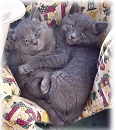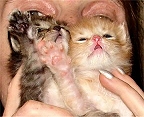UPPER RESPIRATORY INFECTIONS AND CATS
Like people, many cats can develop the sneezing, runny nose, and general lethargy of an upper-respiratory-tract infection. Although the outward signs of a feline upper-respiratory-tract infection resemble the signs of a human cold most of the organisms that infect a cat’s nose and throat have no effect on people. And the opposite is true, human colds will not infect cats.

Feline respiratory infections are very contagious to other nearby cats. Just as a human cold virus can spread quickly through a household or workplace, a feline respiratory infection can to other felines in close proximity. In some cases, the disease can be prevented from spreading by isolation and sanitation of the feeding bowels.
The problem is that most respiratory diseases are air borne and also can contaminate and be transmitted on clothing. Therefore, quick recognition and action are necessary to prevent the infection from spreading to other household or neighborhood cats.
There are many types of constantly changing viruses causing colds and flu in humans. At the present time veterinarian researchers can trace most of the feline upper-respiratory-tract infections to two known viruses: feline viral rhinotracheitis (FVR) and feline calicivirus (FCV). As stated later in the article, there are several different strains of both viruses.
Although both viruses cause similar clinical effects, FVR (also known as feline herpesvirus-1[FHV-1]) usually causes a more severe illness than FCV. A cat suffering from an active FVR infection may sneeze frequently, become lethargic, salivate excessively, and lose its appetite. As the illness progresses, the cat may develop a thick nasal discharge. Some cats also develop conjunctivitis, an inflammation of the membrane that lines the eyelids and parts of the eyeball. FVR infection rarely spreads to the lower respiratory tract (the bronchi and lungs), but when it does, it can cause pneumonia.
FCV infection causes effects similar to FVR infections - although typically milder. Cats suffering from FCV infections often develop painful ulcers on their tongues, lips, or the roofs of their mouths - sometimes with no other sign of respiratory infection. (FVR-infected cats also occasionally develop oral ulcers.) Infrequently, cats with FCV infection may limp (temporarily) due to joint pain and swelling.
Your cat’s immune system may be compromised by a viral respiratory infection. This may allow a secondary bacterial infection to develop and exacerbate the clinical signs of the viral infection. One type of bacteria, Chlamydia psittaci, can cause upper-respiratory-tract infections (sometimes called pneumonitis) even in cats that are not weakened by a respiratory virus.
Chlamydia infections are far less common than viral respiratory infections and usually occur as a local outbreak in a cattery or household. A Chlamydia infection can cause sneezing and a runny nose, but it primarily affects the eyes, causing conjunctivitis in first one eye and then the other. In contrast, when FVR or FCV causes conjunctivitis, both eyes are affected simultaneously. Chlamydia is very susceptible to antibiotic ophthalmic drops or ointments.
Most upper respiratory infections run their course in several days. But, veterinary examinations are highly recommended with any sign of a respiratory disease. Treatment of both diseases FVR and FCV is the same. This includes proper rest, good nutrition, and proper nursing care.
Appetite and water intake are two crucial areas owner should pay attention to. An infected cat may lose its appetite because of debility and discomfort brought on by the illness, a decreased sense of smell due to a stuffy nose, or sores in its mouth that make eating painful.
Owners can try feeding their cat a special food - something the cat really likes or something particularly strong smelling, like sardines, that might arouse the cat’s interest in eating. If a cat stops eating and drinking altogether for a day or more or is eating and drinking poorly for several days, an owner should take the cat in for a veterinary examination.
Veterinarians generally try to avoid hospitalizing cats with upper-respiratory-tract infections because they usually eat better and recover faster at home. However, a veterinarian may recommend putting a dehydrated or malnourished cat in the hospital so it can receive injectable fluids or tube feeding for a few days. The veterinarian may also administer antibiotics if there are signs of secondary bacterial infection.
Upper-respiratory-tract infections are rarely fatal, but can be very debilitating. In some cases these infections can be lethal especially to a kitten, an elderly cat, or a cat with an immune system that is already compromised by another disease. Because kittens face such high risks, owners should contact their veterinarian at the first sign of an upper-respiratory illness in a kitten.
Thanks to the availability of vaccinations against FVR and FCV, upper-respiratory-tract infections are no longer the problem they were before the mid-1970s.
Because FCV (like many viruses) manifests different strains, veterinarians must vaccinate a cat against several strains of the virus to assure reasonable protection. In contrast, FVR is essentially the same virus wherever it shows up, so one type of vaccine does the trick. Even with vaccination, though, a cat may become infected, but the illness is usually less severe and shorter lived than if the cat were unvaccinated.
Pharmaceutical companies have also developed vaccines that provide limited protection against Chlamydia. But because Chlamydia infections are so uncommon, many veterinarians do not routinely vaccinate against them. Vaccination is probably useful in catteries or households with a history of the disease.
Veterinarians typically use a combined vaccine known as FVRCP (feline viral rhinotracheitis, calicivirus, and panleukopenia) to protect cats from FVR, most strains of FCV, and panleukopenia - a life-threatening systemic infection. Vaccination for kittens usually begins at about 7-8 weeks of age. Kittens receive temporary immunity to many diseases from the antibody-rich colostrum in their mother’s first milk.
And during this brief period of temporary "natural" immunity, vaccinations will not have any significant effect as the antibodies in the colostrum will suppress fight against any immunity the vaccine is intended to stimulate. So veterinarians usually wait until kittens are about 6 to 8 weeks old - when their colostrum-induced immunity begins to wear off.
Veterinarians provide follow-up vaccinations at 3- to 4- week intervals until kittens are about 14 to 16 weeks old to provide the greatest possible immunity. Adult cats need an annual revaccination for continued protection. This protocol is now in question, see the article on new concepts of vaccinations for cats.
Many cats that have recovered from the outward signs of upper-respiratory-tract infections remain carriers and continue to shed the virus for months or even years afterward. Even cats that have never shown obvious signs of a respiratory infection may sometimes carry FCV or FVR and shed it.
Carriers of FCV persistently shed the virus in their saliva and nasal discharges - both during illness and after outward signs of illness have passed. Carriers of FVR, on the other hand, experience both latent (non shedding) and active (potentially shedding) phases of the infection.
After the clinical signs of FVR disappear, a cat may enter a latent phase during which the cat shows no signs of illness and does not shed the virus. However, when stressed (by illness or a change in environment, for example), an FVR carrier may enter an active disease phase during which the virus begins replicating in the cat’s body. In response to this surge in viral activity, the cat may once again show clinical signs, such as sneezing or nasal discharge, or may resume shedding the virus with no outward signs of illness.
If a nursing mother is a latent carrier of the FVR virus, her litter may be threatened to a high risk of infection. The stress of nursing often triggers the return of an active viral stage - at the time the kittens’ colostrum-induced immunity wears off. The virus then quickly spreads to the kittens. An owner who knows a nursing mother has had an FVR (or FCV) infection should consult a veterinarian. The veterinarian may recommend weaning the kittens early and separating them from their mother before they can become infected.
Although feline upper-respiratory-tract infections are highly contagious, both FVR and FCV are short lived in the environment. At common room temperatures and humidity levels, FVR rarely survives beyond 18 hours, and FCV survives only for a few days. A cat can transmit either virus (via water droplets) when it sneezes. But another cat can catch the airborne virus only if the sneezing cat is within approximately a 3-foot distance.
Infection spreads most readily from cat to cat by direct contact or shared contact with feeding dishes or toys. Transmission may also occur by transient contamination on the owners clothes. If an owner isolates a cat known to be infected and makes sure that healthy cat house mates do not share its dishes or playthings, the infection is less likely to spread throughout the household. Washing hands after handling an infected cat and even changing clothing may help defer or eliminate the spread of disease. Using a cleaning service at your home or office can help insure that viruses have less a chance to be transmitted.
Ultimately, the best way to avoid a feline respiratory infection is to vaccinate your cat and kittens. Vaccination is the best protection currently available. |


